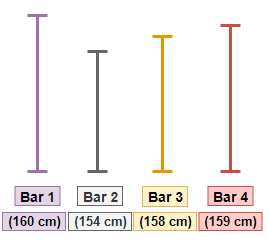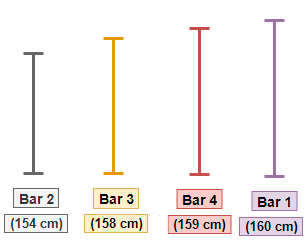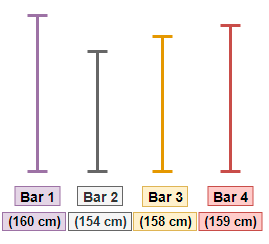Answer
378k+ views
Hint: First of all check the unit of length of all the bars given. If they are the same then leave them but if they are not the same then first convert them into a single unit of length so the comparison can be easy. Once they are converted into the same unit, see the numerical values of the length of all the bars. The bar having the smallest numerical value will be at the first position and the bar having the highest numerical value will be at the last.
Complete step by step solution:
Here we have been provided with four bars of different lengths and we are asked to arrange them in the increasing order of their length. That means the bar with the shortest length will be at the first place and the bar with the greatest length will be at the last.

Now, first we need to check if the unit of length is the same for all the bars or not. Here we can see that all the four bars have their lengths in centimeters, so we need not change them. Therefore, we need to compare the numerical values of the four lengths. So we get,
$\Rightarrow $ 154 < 158 < 159 < 160
$\Rightarrow $ 154 cm < 158 cm < 159 cm < 160 cm
$\therefore $ Bar 2 < Bar 3 < Bar 4 < Bar 1

Hence the above arrangement is our answer.
Note: Note that there are many units used for the measurement of lengths or distances. Some of the basic units used to measure short heights of lengths are millimeter, centimeter, meter. In case we have to compare the lengths having different units then we need to make the unit same for all. This is done by using the relations between several units like: 1 meter = 100 centimeters = 1000 millimeters. You have to remember the relations between units that are used frequently not only for length but for mass, volume etc.
Complete step by step solution:
Here we have been provided with four bars of different lengths and we are asked to arrange them in the increasing order of their length. That means the bar with the shortest length will be at the first place and the bar with the greatest length will be at the last.

Now, first we need to check if the unit of length is the same for all the bars or not. Here we can see that all the four bars have their lengths in centimeters, so we need not change them. Therefore, we need to compare the numerical values of the four lengths. So we get,
$\Rightarrow $ 154 < 158 < 159 < 160
$\Rightarrow $ 154 cm < 158 cm < 159 cm < 160 cm
$\therefore $ Bar 2 < Bar 3 < Bar 4 < Bar 1

Hence the above arrangement is our answer.
Note: Note that there are many units used for the measurement of lengths or distances. Some of the basic units used to measure short heights of lengths are millimeter, centimeter, meter. In case we have to compare the lengths having different units then we need to make the unit same for all. This is done by using the relations between several units like: 1 meter = 100 centimeters = 1000 millimeters. You have to remember the relations between units that are used frequently not only for length but for mass, volume etc.
Recently Updated Pages
Mark and label the given geoinformation on the outline class 11 social science CBSE

When people say No pun intended what does that mea class 8 english CBSE

Name the states which share their boundary with Indias class 9 social science CBSE

Give an account of the Northern Plains of India class 9 social science CBSE

Change the following sentences into negative and interrogative class 10 english CBSE

Advantages and disadvantages of science

Trending doubts
Difference between Prokaryotic cell and Eukaryotic class 11 biology CBSE

Which are the Top 10 Largest Countries of the World?

Fill the blanks with the suitable prepositions 1 The class 9 english CBSE

Differentiate between homogeneous and heterogeneous class 12 chemistry CBSE

Difference Between Plant Cell and Animal Cell

10 examples of evaporation in daily life with explanations

Give 10 examples for herbs , shrubs , climbers , creepers

Write a letter to the principal requesting him to grant class 10 english CBSE

How do you graph the function fx 4x class 9 maths CBSE




